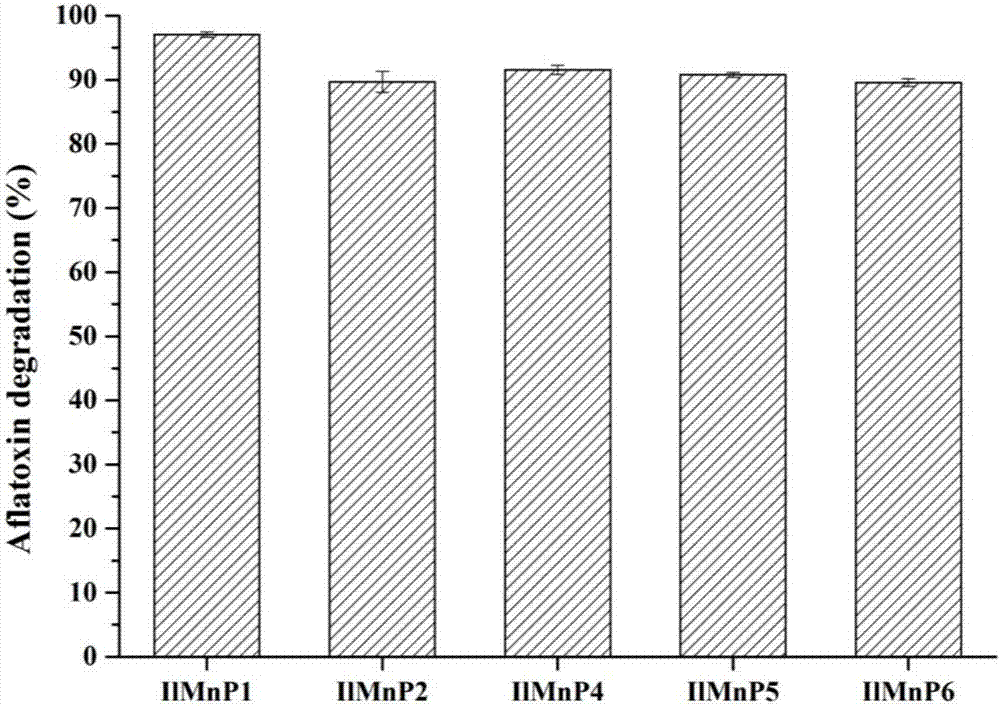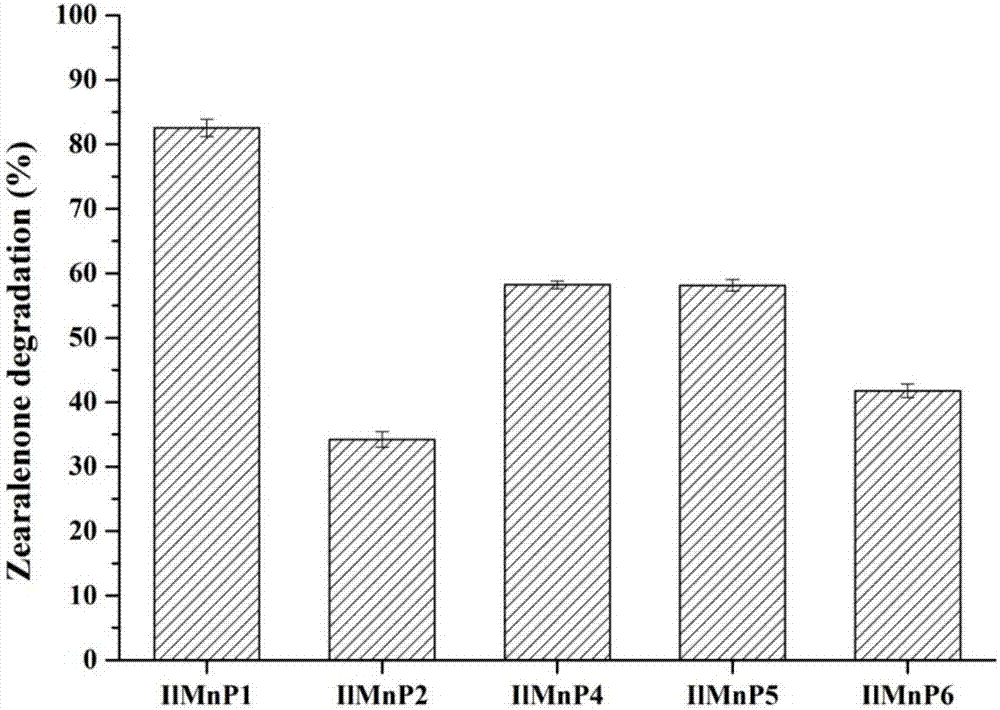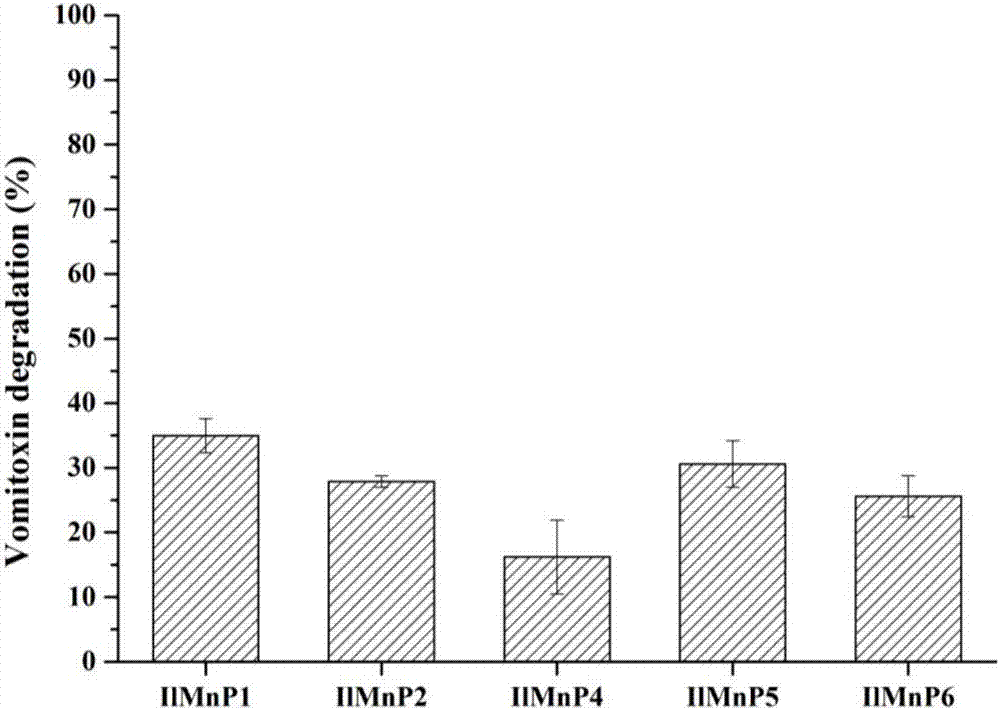Manganese peroxidase, gene of manganese peroxidase and application of manganese peroxidase to mycotoxin detoxification
A technology of manganese peroxidase and mycotoxins, applied in the field of genetic engineering, can solve problems such as unknown mycotoxins
- Summary
- Abstract
- Description
- Claims
- Application Information
AI Technical Summary
Problems solved by technology
Method used
Image
Examples
Embodiment 1
[0111] Cloning of Example 1 Irpex lactus manganese peroxidase coding genes MnP-1, MnP-2, MnP-4, MnP-5 and MnP-6
[0112] Extraction of total RNA from Irpex lactus:
[0113] Collect the mycelia cultured in liquid for 3 days, press dry on filter paper, and thoroughly grind into powder in liquid nitrogen; add 800 μl Trizol reagent to 100 mg mycelia, blow and mix, and place at room temperature for 5 minutes; add 200 μl chloroform, and shake vigorously for 15 seconds , placed at room temperature for 3 minutes, centrifuged at 4°C, 12,000 rpm for 15 minutes; aspirated the supernatant, added an equal volume of isopropanol, mixed well, placed at room temperature for 10 minutes, and centrifuged at 4°C, 12,000 rpm for 10 minutes; discarded the supernatant, and washed the precipitate with 70% ethanol for 1 The second time, the precipitate was dried in the air for 5 minutes; an appropriate amount of RNase-Free deionized water was added to dissolve the RNA, and the RNA concentration was mea...
Embodiment 2
[0131] The preparation of embodiment 2 recombinant manganese peroxidase
[0132] The fragments of genes MnP-1, MnP-2, MnP-4, MnP-5 and MnP-6 encoding manganese peroxidase were subjected to double enzyme digestion to cut out the gene fragment encoding mature manganese peroxidase, and the expression vector pET -28a(+) was subjected to corresponding double digestion. Connect the two to obtain recombinant plasmids pET28a-MnP-1, pET28a-MnP-2, pET28a containing Irpex lacteus manganese peroxidase genes MnP-1, MnP-2, MnP-4, MnP-5 and MnP-6 -MnP-4, pET28a-MnP-5 and pET28a-MnP-6 are transformed into escherichia coli BL21 (DE3) to obtain recombinant escherichia coli strains BL21 (DE3) / MnP-1, BL21 (DE3) / MnP-2, BL21 ( DE3) / MnP-4, BL21(DE3) / MnP-5, BL21(DE3) / MnP-6,.
[0133] Take the DE3 strain containing the recombinant plasmid, inoculate it in 40mL LB culture medium, and culture it with shaking at 250rpm at 37°C for 12h, then transfer it to 300mL LB medium at a ratio of 2%, and culture i...
Embodiment 3
[0134] Embodiment 3 recombinant manganese peroxidase degrades aflatoxin
[0135] Aflatoxin is dissolved in dimethyl sulfoxide and prepared as a 50mg / L mother solution, as follows reaction system: 70 μl malonic acid buffer (0.2M, pH 5.0), 20 μl aflatoxin solution, 5 μl manganese sulfate (40mM ), 100 μl manganese peroxidase (1000 U / L), 5 μl hydrogen peroxide (4 mM). The system without adding manganese peroxidase was used as a control, and each manganese peroxidase was replicated three times. The reaction was carried out at 30°C. After 10 hours, three times the volume of DMSO was added to terminate the reaction, and the degradation rate of aflatoxin was analyzed by high performance liquid chromatography (HPLC). Liquid chromatography is Shimadzu Nexera UHPLC high-performance liquid chromatography analysis system, chromatographic separation column is Zorbax SB-C18 (4.6X250,5um), mobile phase A (water of 0.06% TFA), mobile phase B (acetonitrile of 0.05% TFA ); Gradient elution con...
PUM
 Login to View More
Login to View More Abstract
Description
Claims
Application Information
 Login to View More
Login to View More - R&D
- Intellectual Property
- Life Sciences
- Materials
- Tech Scout
- Unparalleled Data Quality
- Higher Quality Content
- 60% Fewer Hallucinations
Browse by: Latest US Patents, China's latest patents, Technical Efficacy Thesaurus, Application Domain, Technology Topic, Popular Technical Reports.
© 2025 PatSnap. All rights reserved.Legal|Privacy policy|Modern Slavery Act Transparency Statement|Sitemap|About US| Contact US: help@patsnap.com



